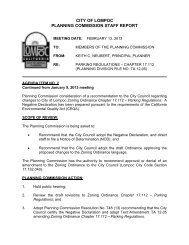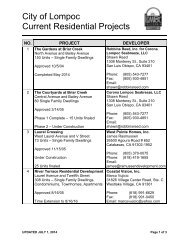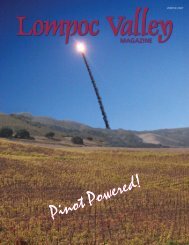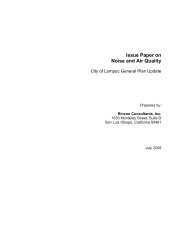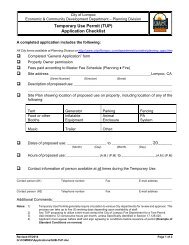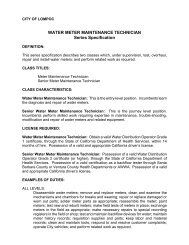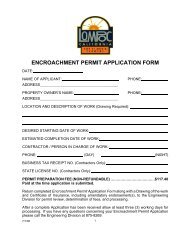Storm Water Pollution Prevention Plan (SWPPP) - the City of Lompoc!
Storm Water Pollution Prevention Plan (SWPPP) - the City of Lompoc!
Storm Water Pollution Prevention Plan (SWPPP) - the City of Lompoc!
You also want an ePaper? Increase the reach of your titles
YUMPU automatically turns print PDFs into web optimized ePapers that Google loves.
Sampling personnel will collect storm water grab samples at discharge locations according to proceduresoutlined in Section 4.5 Quality Assurance and Quality Control. Monitoring checklists are in Appendix F.Appendix C shows <strong>the</strong> monitoring locations for all monitoring.Sampling is not required outside <strong>of</strong> scheduled business hours or under dangerous conditions. An explanation<strong>of</strong> why samples were not taken will be included with on-site inspection documents.<strong>Storm</strong> water SamplingIt is expected that <strong>the</strong> site will have minimal sheet flow. For a qualifying rain event, a minimum <strong>of</strong> 3 samplesper day will be collected, if <strong>the</strong>re is run<strong>of</strong>f from <strong>the</strong> site that originates in <strong>the</strong> project area. It should be ensuredthat storm water discharge collected and observed represent <strong>the</strong> effluent in each drainage area, based onvisual observation <strong>of</strong> <strong>the</strong> water and upstream conditions.Effluent will be analyzed for pH and turbidity and non-visible pollutant parameters (if applicable). Analysis <strong>of</strong>pH will be performed on-site with a calibrated pH meter or a pH test kit. pH analysis only needs to occur whenhigh pH activities (like use <strong>of</strong> concrete, lime, gypsum) are undertaken during predicted rain (like use <strong>of</strong>concrete, lime, gypsum). Turbidity analysis will be performed using a calibrated turbidity meter ei<strong>the</strong>r on-site orat an accredited lab.Risk Level 2 projects are subject to <strong>the</strong> following Numeric Action Levels (NALs):• pH 6.5 – 8.5• Turbidity 250 NTURun-on will be monitored only if <strong>the</strong>re is reason to believe run-on may contribute to an exceedance <strong>of</strong> NALs.In <strong>the</strong> event that <strong>the</strong> storm event average <strong>of</strong> <strong>the</strong> samples exceeds an applicable NAL, Risk Level 2 dischargersmust electronically submit all storm event sampling results to <strong>the</strong> SWRCB’s SMARTS no later than 10 daysafter <strong>the</strong> conclusion <strong>of</strong> <strong>the</strong> storm event. In addition, <strong>the</strong> RWQCBs may request <strong>the</strong> submittal <strong>of</strong> an NALExceedance Report. The discharger must certify each NAL Exceedance Report in accordance with <strong>the</strong>General Permit’s Special Provisions for Construction Activity.Non-Visible Pollutant SamplingIf <strong>the</strong>re is a breach, spill or BMP failure, run<strong>of</strong>f potentially affected by <strong>the</strong> non-visible pollutants will be sampledwithin <strong>the</strong> first two hours <strong>of</strong> discharge. Ensure <strong>the</strong> grab samples collected <strong>of</strong> stored or contained storm waterare from discharges subsequent to a qualifying rain event (That which produces ½ inch or more at <strong>the</strong> time <strong>of</strong>discharge.), and that water samples taken are large enough to characterize <strong>the</strong> site conditions. Collect one ormore samples during any breach, malfunction, leak or spill observed during a visual inspection, which couldresult in <strong>the</strong> discharge <strong>of</strong> pollutants to surface waters that would not be visually detectable in storm water.Also, collect samples that have not come in contact with <strong>the</strong> disturbed soil or <strong>the</strong> materials stored or used onsitefor comparison with <strong>the</strong> discharge sample.Samples will be analyzed for all applicable non-visible pollutant parameters – indicating <strong>the</strong> presence <strong>of</strong>pollutants identified in <strong>the</strong> pollutant source assessment required. The <strong>SWPPP</strong> shall be modified to identify anyadditional pollutants found.It is important to note that covered construction materials or those that are in <strong>the</strong>ir final constructed form, donot need to be monitored. Materials that are stored exposed to precipitation and may generate run<strong>of</strong>f need tobe considered for non-visible pollutant monitoring. Appendix H provides fur<strong>the</strong>r guidance.Non-<strong>Storm</strong> water SamplingIf non-storm water is discharged <strong>of</strong>f site, <strong>the</strong> effluent must be sampled. All non-storm water sample analysesshould be conducted by a state certified laboratory.Municipal <strong>Water</strong> Well No. 11 and Transmission <strong>Water</strong> Main – <strong>SWPPP</strong> July 20, 2010Page 17



